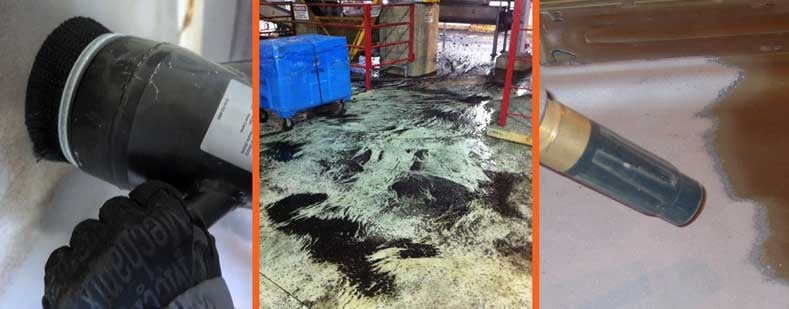Dust is a notorious side effect of abrasive blasting. Blast nozzles introduce a tremendous amount of air to a small area, whipping small pieces of grit, many hundreds of miles per hour into a surface that may be very dirty. As abrasive media come into contact with a substrate, dust is created as the coating is removed, as the abrasive profiles the substrate, and as the abrasive shatters.
Because abrasive blasting is a “dirty” process, engineering controls have been developed over the years to limit dust migration. Below are three tools that abrasive blasting contractors have at their disposal to suppress dust while blasting.
1. Encapsulated Abrasive
Encapsulated Abrasive (like Sponge Media™) traps dust generated at the point of impact with the substrate. Sponge-coated abrasives perform similarly to ordinary dry abrasives, but limit dust by 99%. As Sponge Media collides with the surface, the sponge component compresses, exposing abrasives that remove coatings and profile a metal surface. After the profiling, the sponge particle contracts to its original shape, forming a suction, entrapping what would have become airborne particulate.
This dustless blasting approach should be combined with basic containment to control fugitive emissions from escaping the work area. Encapsulated Abrasives like Sponge Media can be used in many hazardous coating removal projects, such as lead remediation or removal of antifouling coatings on ship hulls.
2. Adding Moisture to the Media
Vapor Blasting or other kinds of wet blasting methods add liquid (often water with a rust inhibitor) to the abrasive mix. This blasting method limits dust well, but can pose additional containment challenges. In many cases, runoff from wet blasting must be contained and treated. Liquid waste from vapor blasting can transport contaminants away from the blasting site, entering the ground and potentially seeping/leaching into the water table. Alternatively (and without proper containment) this same wet waste product finds itself in municipal rain gutters and drains which act like carriers, distributing contaminants to other locations.
Vapor Blasting is sometimes used to remove contaminants from surfaces that have been coated in lead paint. When using vapor blasting to remove any hazardous coating, extreme caution must be exercised to contain the runoff, as it will contain particles of the coating likely beyond allowable limit for non-hazardous disposal. Note that the cost and disposal regulations for wet hazardous waste can greatly exceed those for dry hazardous waste.
3. Vacuum Blasting
Vacuum Blasting is a process in which a high powered vacuum head enshrouds the blast nozzle. As a blaster is working, the vacuum collects most of the dust and some media, transporting it away from the work area. In some work sites with very strict exposure limits, a vacuum box is used in conjunction with a blast nozzle. Blasting production rates are slowed due to the environment created by the suction, decelerating the abrasive before it impacts the surface. Blasters typically have a hard time seeing their work, as vacuum shrouds cover the nozzle and the surface being cleaned. This lack of visual monitoring typically increases the time it takes to assess that the blasting is being done to the standard required. Irregular, non-flat surfaces can also be a challenge to vacuum blast, especially around obstacles like nuts and rivets.








